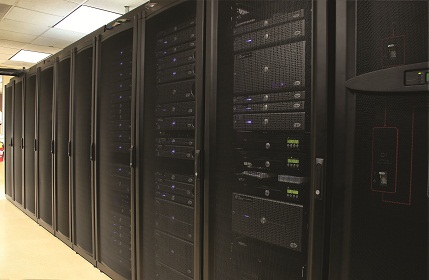
 Call centers—which are increasingly referred to as contact centers—and data centers are facilities that serve different purposes but have some similar requirements in the site selection process. Both facilities are part of the vast array of support systems needed for large companies. As the companies continue to evolve, so does the need for continued evaluation by a site selection consultant.
Call centers—which are increasingly referred to as contact centers—and data centers are facilities that serve different purposes but have some similar requirements in the site selection process. Both facilities are part of the vast array of support systems needed for large companies. As the companies continue to evolve, so does the need for continued evaluation by a site selection consultant.
A data center is a facility designed to house computer hardware necessary to effectively manage mission-critical data for companies and/or their clients. Its purpose is to house network equipment, including website servers, data storage and back-up servers, software applications for large companies and more.
A contact center is a facility utilized by many companies to interact with their inbound customer contacts, whether it’s to place orders, address customer complaints or provide customer service in any other number of areas. They can also be used for outgoing contact for marketing purposes or debt collection. These centers have evolved to include customer interaction via email, online chat and instant messaging and, thus, are becoming more known in the mainstream as contact centers.
Key Criteria Impacting Any Site Selection
There are several key requirements that are predominant in site selection projects overall. These include:
1. Labor costs and availability
2. Highway accessibility and quality
3. Proximity to major markets and customers
4. Availability and cost of real estate options
5. Amount of local and state economic development incentives
6. Availability of telecommunications infrastructure
7. Cost of utilities
8. Tax and regulatory climate
9. Proximity to suppliers
10. Access to a major airport.
 Key Criteria Specific to Data Center Site Selection
Key Criteria Specific to Data Center Site Selection
In addition to the general criteria considered by most projects, there are several factors that are specific to data center projects. These include:
1. Electric Power – Data centers require a great deal of power to run equipment. Choosing a location with desirable electrical rates is an important factor. Access to more than one power grid will enhance a potential location’s profile. The maturity of the grid is also a factor to consider.
2. Property Tax Rates – Property tax rates can have a profound impact on the location of a data center facility due to the capital-intensive aspect of these types of projects.
3. Natural Disasters/Weather Events – Weather events and natural disasters, such as hurricanes, floods, tornadoes and earthquakes, have the potential to interrupt operations and are of great concern when locating data centers. Companies cannot afford to experience business disruption due to a data center going down.
4. Construction Costs/Quality – Data center operations have the potential for high construction costs. Understanding these costs in different geographic areas must be evaluated during the site selection process.
5. Telecommunications Infrastructure Availability, Cost and Redundancy -- Telecommunications infrastructure is critical to data center operations. Redundancy of infrastructure and multiple carriers are critical to minimize risk.
6. Quality-of-Life Amenities – Data centers, typically, employ highly skilled workers who want to work and live in an environment where they can enjoy quality-of-life amenities.
As site selection consultants and their clients consider where to locate data centers, proximity to the corporate headquarters becomes less important and the special requirements of the data center itself become more important. The initial capital investment necessary to construct and equip a data center, along with ongoing operating expenses (led by energy costs and property taxes), are significantly higher than most other types of site selection projects. This results in operating expenses being near the top of the list of site selection criteria.
Equally important is the fact that companies cannot afford to experience business disruption due to a data center failure. Potential locations with the fewest incidents of natural disasters can move into a very favorable position in a data center site selection process.
 Driven by costs savings, data centers are experiencing trends related to operating expenditures. For many smaller and medium-sized companies, consolidating data centers creates simplicity in the system and efficiencies in power consumption. Fewer data centers may result in less power being consumed, less real estate being utilized, less hardware maintenance being required, and give companies the opportunity to address inefficiencies and disaster recovery plans. Large companies are, however, increasing the number of data centers around the globe. This not only provides them the ability to continue to grow in server capacity and improve disaster recovery preparedness, but it also creates the ability to shift data loads when and where the power source is currently the most affordable and reliable.
Driven by costs savings, data centers are experiencing trends related to operating expenditures. For many smaller and medium-sized companies, consolidating data centers creates simplicity in the system and efficiencies in power consumption. Fewer data centers may result in less power being consumed, less real estate being utilized, less hardware maintenance being required, and give companies the opportunity to address inefficiencies and disaster recovery plans. Large companies are, however, increasing the number of data centers around the globe. This not only provides them the ability to continue to grow in server capacity and improve disaster recovery preparedness, but it also creates the ability to shift data loads when and where the power source is currently the most affordable and reliable.
Key Criteria Specific to Contact Center Site Selection
There are several specific requirements that are evaluated that are key areas to consider when selecting a site for a contact center. These include:
1. Labor Pool Quality and Costs – Contact centers require a large number of employees and, depending on the industry, tend to use part-time employees, job-sharing situations and college students who have good communication and interpersonal skills. Locating near a large university town with adequate mass transit could be a priority. If the company tends to service a bilingual customer base, then locating in a city such as Tucson, Phoenix, Albuquerque, El Paso or San Antonio might provide a better bilingual labor pool. Labor cost is also a critical component of the site selection process for a contact center.
2. Telecommunications Infrastructure and Electric Costs – As the contact center is dependent upon a telecommunications infrastructure, it is important to have access to high-speed communication lines and multiple carriers. Multi-trunk telecom lines and carriers are essential to ensure there is no interruption in the contact center operations. While not on the same level as data centers, electric costs can be an important factor due to the 24 hour/7 day nature of some contact center facilities. 3. Facility Operating Costs – As contact centers often are open extended--or even all--hours in a day, operating costs, including people-specific infrastructure such as electricity and water, become of higher importance. In addition, contact centers usually have their own cafeterias and large parking lots that can add to both operating costs and initial infrastructure expenses.
3. Facility Operating Costs – As contact centers often are open extended--or even all--hours in a day, operating costs, including people-specific infrastructure such as electricity and water, become of higher importance. In addition, contact centers usually have their own cafeterias and large parking lots that can add to both operating costs and initial infrastructure expenses.
4. Building Infrastructure – Contact centers employ a higher number of people per square foot than a typical office building. Large open spaces with good ventilation can provide a contact center with the ability to put many cubicles in place for individual contact center agents.
The site selection consultant must consider the client’s top priorities when evaluating where to locate contact centers. The high volume of employees needed to operate a contact center makes labor pool quality and costs a key site selection factor. However, the contact center is much different in its labor pool needs. Access to workers who have appropriate communication skills and flexible schedules are preferred and require the site selector and its client to be diligent in analyzing the demographics of the workforce in any location that is being considered. Somewhat similar to data centers, the initial capital investment to construct and equip a contact center can be expensive – this is why the re-use of existing facilities has become more prominent for contact center projects. Telecommunications infrastructure is also a top criterion when locating a contact center.
Labor Pool
As high-quality labor at a reasonable cost is needed to efficiently operate a contact center, due diligence in researching the demographics of the labor market in any location being considered is a necessary step. There should be an effort to locate the contact center within a 30-minute commute of such available labor markets.
1. Educational Attainment – Often, two-year and four-year college degrees are important requirements for employees in contact centers. In particular, technical support contact centers require higher levels of education.
2. Labor Cost – Labor cost is also a critical factor in the site selection process for contact centers. Due to competitive pressures, managing the cost of labor can have a profound impact on the success of a contact center.
 Utility Needs
Utility Needs
The availability, cost, and reliability of the utility infrastructure are essential components to evaluate when choosing a site for a contact center.
1. Telecommunications Infrastructure Availability, Cost and Redundancy – For a contact center, the telecommunications infrastructure is the most important factor. While labor is high on the list of importance, contact center agents have the ability to work off-site, which can help to lower its place in the hierarchy. Therefore, telecommunications reliability and redundancy are key decision influencers when choosing where to plant the center. Remember that multiple carriers, including multiple long-distance carriers are essential for a contact center. A solid and reliable data line for email, instant messaging and chat communications with customers must be available and have redundancy plans in place.
2. Electric Power – Locations with lower electrical rates will be considered more attractive during the site selection process because, as mentioned above, contact centers are open for extended hours and require a larger amount of power to operate than a typical eight-to-five office building.
 Trends
Trends
A few key trends have developed in the contact center industry. For one, because a contact center has more employees per square foot than many other types of business, the redevelopment of an abandoned grocery or big box store to serve as a contact center is occurring more frequently. Two of the reasons for this are:
1. Parking -- Large abandoned retail centers often have abundant parking.
2. Large Open Space – Contact centers need large open spaces with good ventilation, due to the volume of employees and computers and redeveloping a former big box retail or grocery venue provides both. They tend to be simple large spaces that can be configured for a contact center quite easily. Teaming the large space with high ceilings makes it an easier redevelopment of existing real estate.
A second trend in contact centers is that of re-shoring. For many years, the costs associated with the American labor force led to more overseas contact centers. In recent years, however, contact centers have started to move back home. That’s because businesses learned that customers expect the same level of service over the phone or Internet that they receive in-person in a store, which was not occurring with off-shore contact centers.
In the 2010 Contact Center Satisfaction Index, a study by CFI Group (www.cfigroup.com), customers rated their experience with contact center agents 21 points higher if they thought the call was handled in the United States, as opposed to if they thought the call was handled outside of the U.S. The top reasons for customer call dissatisfaction were difficulty in understanding the agent and the number of agents who had to be spoken with for problem resolution. This has created a shift in bringing some of those contact centers back into the U.S., with hopes to increase customer satisfaction and loyalty.
Conclusion
Although data centers and contact centers have some similar requirements, such as solid utility and telecommunications infrastructure, each also has very distinct requirements. The very high volume of employees needed for a contact center creates completely different needs than that of a data center with fewer employees. Therefore, parking and real estate requirements become more relevant in the search for a contact center site. However, both types of facilities have the need for redundancy in utilities and telecom. Neither a contact center nor a data center can afford to experience a disruption in operations at any time of the day or night, since both operate for extended, if not continuous, periods. The site selector must carefully evaluate many specific key criteria for these industries as they continue to grow and expand. The bottom line is site selectors must not underestimate the amount of detailed research and location modeling necessary for a contact- or data-center client to successfully complete a project.

